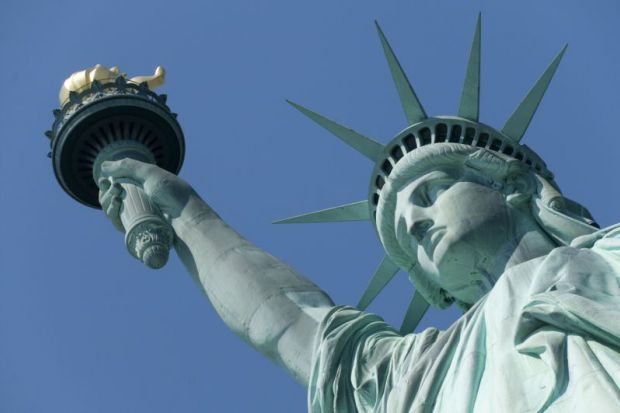An iconic bronze statue of Booker T. Washington has adorned the main entrance of Tuskegee University since 1922. Known as Lifting the Veil of Ignorance, it captures the black civil rights leader proudly unveiling a newly freed, education-driven man.
Ralph Ellison later critiqued the fictional veil lifter in his award-winning novel, Invisible Man. Ellison’s nameless protagonist gazes, “unable to decide whether the veil is being lifted or lowered more firmly into place”. He wonders whether he is “witnessing a revelation or a more efficient blinding”.
For nearly 250 years, a veil has fluttered over American democracy’s full actualisation. Only occasionally throughout US history has the veil been lifted like a knee removed from the neck of progress.
So how do we definitively unveil the fully democratised America Langston Hughes imagined as “the dream the dreamers dreamed”, and Martin Luther King envisioned as “the beloved community”? Can we finally actualise the world that they, and so many other historically black college and university [HBCU] graduates, compassionately envisioned?
While the task will undoubtedly require the cooperation of multiple stakeholders, American higher education must play a pivotal role.
Think about it.
Have you ever wondered why America’s civil rights movement took so long to emerge? Why wasn’t it led by Ivy League students and alumni, as encouraged by their faculty and presidents? After all, for its first two-plus centuries, the primary harvest of US higher education was a “learned” ministry and a “Christian” mindset.
Yet instead of the refined moral consciences of these pastoral presidents compelling them to end human enslavement, the earliest leaders and influencers of Ivy League institutions also enslaved people. And Princeton University once held a slave auction on campus.
The record is clear. Rather than advance democracy, most of America’s campus leaders have resembled bystanders, largely reticent about the world’s injustices. Few of them have chosen to disturb the “peace” without first considering how their declarations might also disturb the wealthy. A contrasting shortlist of distinctive “upstander” college presidents includes Alexander Meiklejohn, Mary McLeod Bethune, Father Theodore Hesburgh and Benjamin Elijah Mays.
But what characterises an upstander presidency today? Campus leaders must make at least two basic shifts to bolster their effectiveness as agents of positive change.
First, today’s college presidents should shift from a “contractor mindset” to that of an architect. The higher education historian Laurence Veysey examined undergraduate and graduate formation patterns and confidently affirmed the durability of the structures and innovations in place by 1910. In his view, that era’s architectural designs were so unassailable that all future campus leaders needed to function as mere “contractors”, presiding in thematically similar ways.
Veysey’s conclusion, made in 1965, was prescient. Since then, most presidencies have sadly attracted “contractor-types”, capable of managing the largely routinised toil. Most presidents feel pressured to keep their institution alive, never mind positioning the campus to truly thrive. And in our increasingly vocation-driven ecosystem, they are forced to privilege skill set development over mindset enrichment or civic engagement. Leaders today are left with little bandwidth for considering the most significant challenges facing the larger society.
Thus, presidential expectations and outcomes have steadily accrued a dull uniformity. And, despite their best intentions, as their daily grind progressively taxes their contractor-like execution proficiencies, most presidents unwittingly morph into silent bystanders in an increasingly volatile and fragile world.
If our newest leaders can reinvigorate an architect’s mindset, they can operate on an entirely new, democracy-friendly wavelength.
Second, those awakened architectural sensibilities should prompt today’s campus leaders to heed the design advice of two of America’s greatest public intellectuals. W. E. B. Du Bois and John Dewey thought similarly about education’s duty to measurably advance the common good. Informed by HBCU-style, servant-leadership imperatives, Du Bois insisted that what happens in the classroom should improve the world and “raise the level of civilization”. Dewey proclaimed, “democracy has to be born anew every generation and education is its midwife.” No pressure, huh?
No, pressure. Look at us.
Rampant anti-democratic behaviour extends well beyond the subversion of free and fair elections. Excesses now include spikes in toxic rhetoric and hate speech, declines in trusted journalism, reversals of basic human rights, unchecked mass shootings and fascistic book-banning. Worse yet, this volatility, including the political and racial disharmony, are not confined to America’s borders. Many nations are now wobbly as they contend with an uncertain future.
Thus, democracy’s general brokenness, and the mindset advice from Du Bois and Dewey, combine to compel a re-architecture of the norms, nature, rhythm, goals and outcomes of today’s campus life and presidency, worldwide.
Fortunately, a blueprint already exists. HBCUs authored America’s only college experience that expressly targeted a just, multiracial world, pursuant to the equity and equality themes of America’s founding documents. By refining a student-centric pedagogy and a mission-driven culture, key HBCUs produced the generals and foot soldiers of an unprecedented civil rights movement. In the process, they transformed our understanding of how we might finally become our best selves. Since that mid-century feat, no other campus-based initiative has measurably advanced us towards a perfected union. Only by updating, scaling and echoing the best of that tradition’s still relevant design innovations will we finally be able to unveil a fully actualised American democracy.
Perhaps the fluttering veil at Tuskegee’s entrance is a warning. Pursuant to making the world safe for true democracy, it makes sense to imagine a veil fluttering not only at Tuskegee’s entrance, but at that of every nation in the world, but especially at America’s entrance…over the Statue of Liberty. And whether those more consequential veils are lifting or lowering is up to us.
John Silvanus Wilson Jr was executive director of the White House Initiative on Historically Black Colleges and Universities during Barack Obama’s first presidential term, a former president of Morehouse College, and is now director of the Millennium Leadership Initiative at the American Association of State Colleges and Universities. His book Hope and Healing: Black Colleges and the Future of American Democracy was published by Harvard Education Press last month.
Register to continue
Why register?
- Registration is free and only takes a moment
- Once registered, you can read 3 articles a month
- Sign up for our newsletter
Subscribe
Or subscribe for unlimited access to:
- Unlimited access to news, views, insights & reviews
- Digital editions
- Digital access to THE’s university and college rankings analysis
Already registered or a current subscriber? Login








